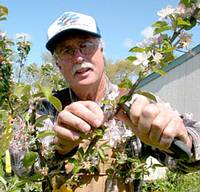 今年2月間,美國人發起一項「花季追蹤計畫」(Project BudBurst),鼓勵各州學生、園藝人士和科學家觀察身邊植物含苞、開花和落葉的時間點,登錄於線上資料庫,便可協助研究人員蒐集全美各地數據而更了解暖化氣候。
今年2月間,美國人發起一項「花季追蹤計畫」(Project BudBurst),鼓勵各州學生、園藝人士和科學家觀察身邊植物含苞、開花和落葉的時間點,登錄於線上資料庫,便可協助研究人員蒐集全美各地數據而更了解暖化氣候。
動植物都受氣候變遷影響,有些植物因應暖化而延長生長季,有些則將生長適宜溫度範圍往上提升,或向高緯度遷徙。
許多昆蟲物種的繁衍週期是隨日照長短變動,而非氣溫,暖化則使植物開花時間比傳粉昆蟲所「預期」要早,這種現象已在全球多處出現。 季追蹤計畫由美國大學大氣研究聯盟(University Corporation for Atmospheric Research,UCAR)主持,可讓人類更了解氣候變遷對環境的影響。
計畫主持人、UCAR教育推廣部韓德森(Sandra Henderson)表示:「氣候變遷隱而未顯地影響我們的後院和社群。」去年春天,26州數千名志工登錄數百種植物落葉和開花時間,這個小規模實驗促成今年的花季追蹤計畫。
花季追蹤的參與者可從網站建議的60多種種植物,選擇一種以上觀察,或自行挑選其他物種;要從歷年平均開花日一週前,花苞已開、樹葉長出的階段開始觀察。
開花後,參與者需持續觀測後續生長,例如第一片葉、第一朵花和種子傳播。當他們將資料輸入後,可以看到其他人輸入的全美各地資料。
生物氣候學(記錄動植物隨氣候循環之行為表現的學門)有悠久歷史,在日本和中國,櫻花和桃樹的開花季節千年來都和傳統節慶相連。根據日本國家氣象局資料,目前日本的櫻花季比1950年提早四天。
花季追蹤計畫合作團隊包括植物保育聯盟、美國國家氣候聯合網、亞歷桑納大學、加州大學、加州聖塔芭芭拉大學、威斯康辛大學密爾瓦基和麥迪遜分校。計畫網頁在 http://www.budburst.org。
By noticing when plants bud, flower and leaf out, volunteers can track climate change as part of a nationwide initiative starting Friday. Project BudBurst allows students, gardeners, and other citizen scientists in every state to enter their observations into an online database that will give researchers a detailed picture of the warming climate.
Plant and animal species throughout the world are being affected by climate change. Some plants respond to warmer temperatures by extending their growing seasons. Others shift their ranges toward the poles or to higher elevations.
At the same time, many insects breed and disperse based on regular cycles of sunlight rather than temperature. This can cause a mismatch between the behavior of pollinating insects, such as bees, and flowers that bloom earlier than the insects expect. These mismatches have already been noted across many parts of the world. Project BudBurst is an effort to extend human understanding of how climate change is affecting the environment. The project is operated by the University Corporation for Atmospheric Research, UCAR, a consortium of 70 universities.
"Climate change may be affecting our backyards and communities in ways that we don't even notice," says project coordinator Sandra Henderson of UCAR's Office of Education and Outreach. Project BudBurst builds on a pilot program carried out last spring, when several thousand participants recorded the timing of the leafing and flowering of hundreds of plant species in 26 states.
Each participant in Project BudBurst selects one or more plants to observe. The project website suggests more than 60 widely distributed trees and flowers, with information on each. Users can add their own choices. Participants begin checking their plants at least a week prior to the average date of budburst - the point when the buds have opened and leaves are visible.
After budburst, participants continue to observe the tree or flower for later events, such as the first leaf, first flower and, eventually, seed dispersal. When participants submit their records online, they can view maps of these events across the United States.
The science of phenology, or tracking cyclic behavior among plants and animals, has a distinguished history. In Japan and China, for example, the blossoming of cherry and peach trees is associated with ancient festivals, some of which extend back more than a thousand years. Cherry trees in Japan now bloom four days earlier than in the 1950s, according to the nation's meteorological agency.
Project BudBurst collaborators include the Plant Conservation Alliance; USA-National Phenology Network; and the universities of Arizona; California, Santa Barbara; Wisconsin-Milwaukee; and Wisconsin-Madison. Find Project Budburst on the Internet at: http://www.budburst.org


